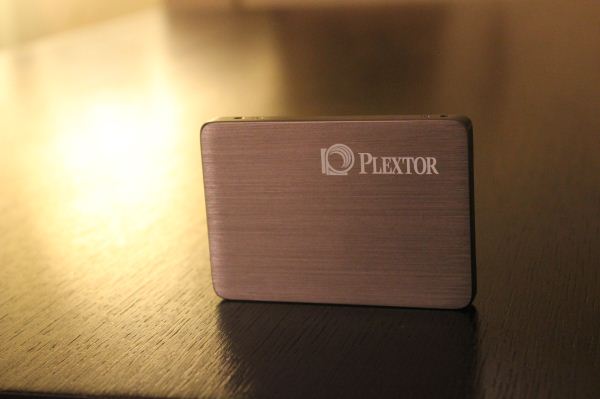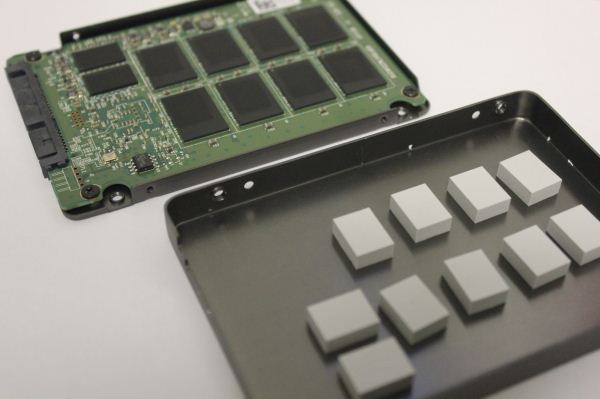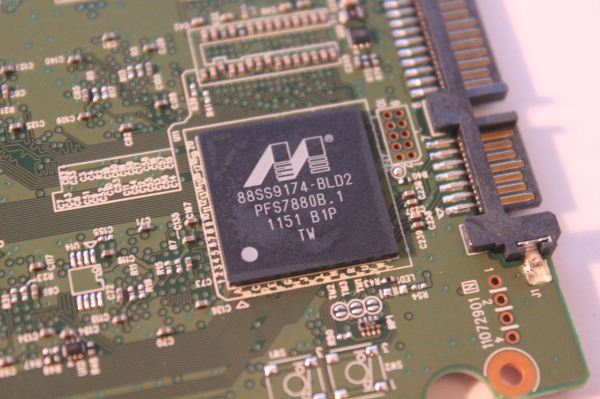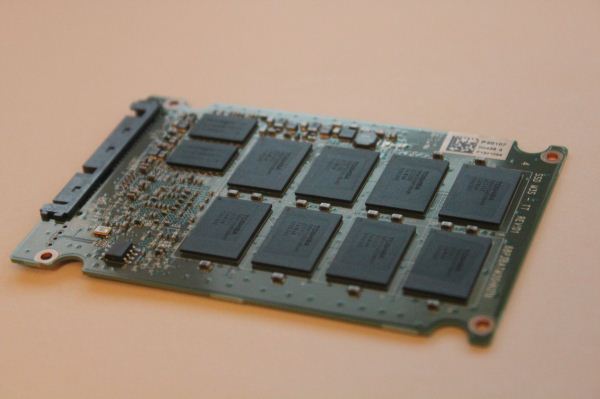The Plextor M3 (256GB) Review
by Kristian Vättö on April 5, 2012 3:05 AM ESTThe Plextor M3
Plextor sent us a 256GB model of their M3 series. Below is a table containing the specifications of their M3 line.
| Plextor M3 Specifications | ||||
| Model | PX-64M3 | PX-128M3 | PX-256M3 | PX-512M3 |
| Raw NAND Capacity | 64GiB | 128GiB | 256GiB | 512GiB |
| Formatted Capacity | 59.6GiB | 119.2GiB | 238.5GiB | 476.9GiB |
| Number of NAND Packages | 8 | 8 | 8 | 8 |
| Number of die per Package | 1 | 2 | 4 | 8 |
| Sequential Read | 520MB/s | 510MB/s | 510MB/s | 525MB/s |
| Sequential Write | 175MB/s | 210MB/s | 360MB/s | 445MB/s |
| 4K Random Read | 55K IOPS | 70K IOPS | 70K IOPS | 56K IOPS |
| 4K Random Write | 40K IOPS | 50K IOPS | 65K IOPS | 30K IOPS |
| Cache (DDR3) | 128MB | 256MB | 512MB | 512MB |
The Plextor M3 is available in all the standard capacities. In the light of the performance specifications, the M3 looks very promising. It beats its closest match, the Crucial m4, in all aspects. It's very competitive even with SandForce based SSDs and especially the stated random read figures are great.
| NewEgg Price Comparison (4/2/2012) | ||||
| 64GB | 128GB | 256GB | 512GB | |
| Plextor M3 | $110 | $180 | $340 | $660 |
| Crucial m4 | $88 | $155 | $315 | $630 |
| Intel 520 Series | $110 | $180 | $345 | $800 |
| Samsung 830 Series | $105 | $185 | $300 | $780 |
| OCZ Vertex 3 | $90 | $178 | $340 | $770 |
Price wise the M3 is not the cheapest SSD, especially in the smaller capacities. There is about $10-15 premium in the 64GB and 128GB models but 256GB and 512GB models are more competitively priced. Crucial's m4, however, comes in as a cheaper option than the M3 at every capacity so that will be a key matchup where Plextor has to win on performance or come down in pricing.
The external design of Plextor M3 is very solid. When I first saw it, it reminded me of Samsung 830 with its brushed metal finish. Only the Plextor logo has been printed on the front—The model and other important information are printed on a sticker on the back of the drive. The drive package includes a 3.5" bracket, quick installation guide, and a software CD, which includes a clone&backup utility along with performance analyzer. Plextor is giving the M3 a top notch 5-year warranty as well.
Each of the main components (controller, NAND devices, and DRAM) have their own little thermal pad. Since the chassis is also made out of metal, heat dissipation should not be a problem.
Inside we find Marvell’s 88SS9174-BLD2 controller (or just 9174). This is the same controller that's in Crucial's m4, but the firmware is custom developed by Plextor. It’s actually a bit surprising, yet very refreshing, to see a Marvell based SSD for a change. Everyone seems to have a SandForce solution these days. We have seen that Marvell can be competitive; you just need to take the time to customize the firmware to get good performance. The stock SandForce firmware is fast enough, so it's obvious that many companies choose to go with the easiest option.
Flip the PCB and we find eight Toshiba 24nm 2-bit-per-cell MLC NAND devices. That’s coupled with two 256MB DDR-1333 chips from Nanya, giving a total of 512MB of DDR3 cache.
Toshiba uses a Toggle-Mode interface and the current iteration (2.0) of Toggle-Mode NAND is good for up to 400MT/s per interface. Rating speed by transfers is a bit annoying as it doesn't tell us the actual bandwidth—for that we need the width of the channel and transfers per second. The channel in this case is 8 bits wide, so that works out to be 3.2Gbps per interface, or 400MB/s. With eight NAND packages, the maximum throughput works out to be 3200MB/s, over four times more than what SATA 6Gb/s can provide. Of course, reading from NAND and dumping the data into a register is one thing; it's another matter to actually transfer the data to a host controller over the interface.
We want to provide a quick word about firmware updates before we go into benchmarks. The drive came with FW 1.01, which was the latest at that time. Plextor has recently released FW 1.02 which is supposed to fix some issues but all our tests have been done using FW 1.01. Plextor is not claiming increased performance in the release notes of the update. The actual process of updating the firmware is very simple. Download a small ISO (~3MB) from Plextor's site, burn that to a CD or USB stick and boot from that. Press Enter and it automatically flashes the drive. I even had all my other drives plugged in and there was no problem.
The Test
| CPU |
Intel Core i5-2500K running at 3.3GHz (Turbo and EIST enabled) |
| Motherboard |
AsRock Z68 Pro3 |
| Chipset |
Intel Z68 |
| Chipset Drivers |
Intel 9.1.1.1015 + Intel RST 10.2 |
| Memory | G.Skill RipjawsX DDR3-1600 2 x 4GB (9-9-9-24) |
| Video Card |
XFX AMD Radeon HD 6850 XXX (800MHz core clock; 4.2GHz GDDR5 effective) |
| Video Drivers | AMD Catalyst 10.1 |
| Desktop Resolution | 1920 x 1080 |
| OS | Windows 7 x64 |
Our regular readers may notice that my testbed is not exactly the same as Anand's. Anand's setup is based on Intel's motherboard with H67 chipset, whereas mine is an ASRock board based on Intel's Z68 chipset. The important bit here is that both feature native SATA 6Gb/s support and both setups use the same drivers. Other features and components don't really have an effect on SSD testing. For example the average CPU usage during write speed tests is less than 5%.














113 Comments
View All Comments
Pr101 - Thursday, April 5, 2012 - link
Yeah, you just happened to do a review when other ssds were low in price/on sale and the Plextor was high/not on sale. I'd also use m4 prices of the ones that come with a 2.5 to 3.5 bracket for comparison. Anyway, nice review...Kristian Vättö - Thursday, April 5, 2012 - link
I checked the prices one week apart (updated the prices so they wouldn't be that old) and Plextor was the most expensive throughout this period. Other drives are actually more expensive now than they were a week ago. But yeah, the prices fluctuate a lot so it's fairly hard to recommend one just based on prices.SetiroN - Thursday, April 5, 2012 - link
For its bundle, warranty and overall performance (never at the top but in every case amongst the top drives), I'd easily consider this the best drive on the market.As much as I understand the reliability concerns, Plextor is well known for their quality control, and for them to offer 5 yrs I'm pretty sure you can feel safe about it. This is not OCZ we're talking about.
TBH I find it silly to ask for a $10 discount when competitors are offering much less in terms of warranty and bundling.
Kristian Vättö - Thursday, April 5, 2012 - link
I'm not saying that the drive is not worth the extra $10, but it can be hard for a buyer to justify the extra. There are free utilities that do the cloning job as well (although shareware is usually easier to use). I also think that most consider 3-year warranty to be 'good enough'.Especially 64GB is all about price as you're already making a compromise by getting such a small SSD.
7Enigma - Thursday, April 5, 2012 - link
Shockingly after dealing with 2 failed attempts at using freeware (EASEus and another program) I ended up having sucess with the Windows 7 Image backup and built in drive manager.I was going from a new laptop 500GB HDD with about 92GB on it to a 128GB Crucial M4. First thing was to reduce the size of the partition on the 500GB to less than 128. This wasn't as easy as it sounded as apparently the page file gets randomly placed on the drive. in my case it was placed at the middle of the platter and so I couldn't shrink the 500GB partition down until I first temporarily set the page file to 0MB and then repartitioned. After figuring out that little quirk and repartitioning down to under 95GB I did a recovery image onto an external HDD (this was a laptop with a single drive bay).
Then using the bootable recovery windows cd I simply swapped out the old 500GB drive for the new M4 SSD, booted with the recovery disk, pointed to the image on the external drive, and sat back and within the hour (very slow external HDD!) was back up and running perfectly.
Sure some of those other pay-for programs are probably easier to use, but this one didn't require any additional software (other than downloading Windows recovery cd), and a bit of hair-pulling to work out the quirks.
JarredWalton - Thursday, April 5, 2012 - link
I've used Clonezilla quite a few times, but I wish they would add a feature to allow you to shrink a clone to a smaller drive (assuming the data will all fit). You pretty much have to do the same thing you just mentioned: eliminate the swap file and hibernate file, resize the partition to less than your target size, then clone/Rick83 - Thursday, April 5, 2012 - link
It would be interesting to see not only power consumption measures, but also max-load efficiency values.In the "race-to-idle" scenario, that we want to see on mobile hardware, it can often be beneficial to consume a little extra power during a short time span, but then allow the entire system to idle as early as possible.
Knowing the Watts per Throughput ratio could be helpful, and allow an easier comparison of effective/actual power consumption.
Kristian Vättö - Thursday, April 5, 2012 - link
I totally agree. Power consumption during sequential/random write does not give the big picture. A fast drive with high peak power consumption may consume less power overall because it does the job faster than a slower drive with lower peak power.Ideally, I think it would be the best to measure how much power was used during our Heavy/Light test suites, that would be a more real life scenario. How to do that accurately is another question, but I'll definitely keep this in mind :-)
James5mith - Thursday, April 5, 2012 - link
Anyone who has been involved in computers since the time of the first CD burners knows Plextor. Their 16x10x40 CD-RW drives were the cream of the crop and highly prized. I still have one despite not having an IDE channel to plug it into. I just can't bring myself to toss it.Spawn73 - Thursday, April 5, 2012 - link
You´d must´ve been living in a hole to not have heard of Plextor. They're famous for their high quality CD-burners.Couldn't the reviewer Wiki the company or something before making a blanket statement about a company being unknown?